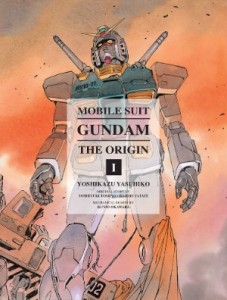By Yoshikazu Yasuhiko; Original Story by Yoshiyuki Tomino and Hajime Yatate; Mechanical Design by Kunio Okawara. Released in Japan by Kadokawa Shoten, serialized in the magazine Gundam Ace. Released in North America by Vertical.
If you’re going to rewrite one of the most renowned and influential anime of all time, you have a lot of difficulties ahead of you. You have to tell the same story but add your own spin on it, making sure it’s not just a word-for-word copy. You need to draw the audience in by showing things that you were unable to the first time, for either budget or time reasons. And of course you need to remind everyone why the original was so legendary. It helps, of course, when you’re actually one of the architects of that original vision. And that’s what we have here, as one of Gundam’s creators has decided to tell the original story from the 1979 anime as a manga, adapting, expanding, and illuminating its plot and characters. And so far, I’m impressed.
I must admit, I’ve never gotten into the Gundam phenomenon – as a kid, Battle for the Planets was more my speed, which is about a generation earlier in mecha shows, and I didn’t really follow the Wing/Seed phenomenon. That said, I do know a few things by fandom osmosis. Giant robots, only serious. War is bad. Char Aznable. Lots of tragic deaths. Colony drops. And everyone hates Turn A. That pretty much sums up my knowledge. So I was looking forward to delving into this to see what made it so compelling. The story begins in media res, as we follow a platoon of commandos trying to get into on a secret new weapon the enemy ship has… which turns out to be a Gundam, as we realize the enemy ship is actually Our Heroes.
This feels very much like an epic motion picture, and at times it almost felt like I was reading storyboards rather than a manga volume. Events slide smoothly from one to another, with little to no chance for a breather in between. The lead character, Amuro Ray, is somewhat sullen and teenagery, but not as hard to like as I’d thought, and clearly shows compassion when it’s in his sphere of things he cares about. (There’s a beautifully drawn shot of his childhood friend Fraw running towards him as a huge explosion bursts behind her, and I was sure this would be the first of many deaths, but amazingly no; the “named character” body count in this volume is pretty low.) As for Char, it’s immediately apparently why he is the breakout character from this series. Cool and cocky, but lacking the evil arrogance of some of his friends (like the guy we see right at the cliffhanger), he’s a bad guy you love to hate. Also, his mobile suit is named the Red Comet, which just makes me imagine that the Zeon base is at Cedar Point.
On the presentation end, Vertical has produced possibly its most impressive book to date, with a gorgeous hardcover with thick pages (many color), suitable for any coffee table. It really goes above and beyond the call of duty; kudos to the designers. That said, the main reason to get the Gundam manga is probably the same reason the original anime became so legendary; you can’t stop wondering what happens next. These people and their struggle to survive are amazingly compelling, and everything about this manga adaptation – the plot, the artwork, the characterization – makes it justify its existence. I am very happy to see it coming out here, and can’t wait for more.
Oh yes, and red makes things go three times faster. I remember that as well.


“Lots of tragic deaths.”
The original Gundam does have a fair bit of this, yes, but not quite the meatgrinder approach of some of Tomino’s later shows. Must have still been a surprise for viewers who were used to the giant robot shows before it, though.
“Oh yes, and red makes things go three times faster.”
They toned that down to Char’s suit being 30% faster in the movie version. There’s a kind of push-and-pull between old-fashioned giant robot shows and the ‘real robot’ subgenre genre that Gundam was creating, all through the TV series.
As I recall, the big difference to the plot of the original in this volume is the battle with the prototype Gundam, which didn’t have a precedent. The other changes are much lower-key — did the bit where Amuro fights his first battle while referring to the manual go? Rather a shame if it did.